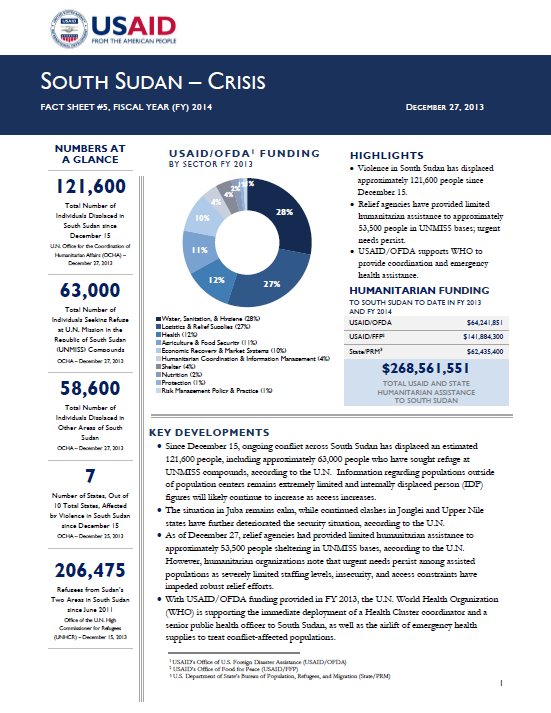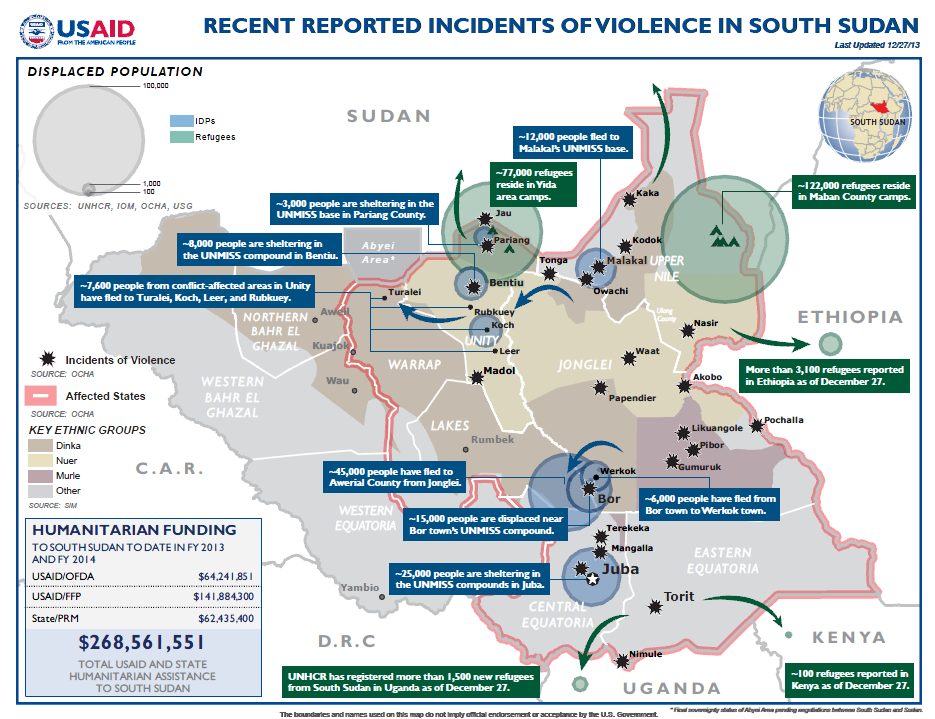- What We Do
- Agriculture and Food Security
- Democracy, Human Rights and Governance
- Economic Growth and Trade
- Education
- Environment and Global Climate Change
- Gender Equality and Women's Empowerment
- Global Health
- Humanitarian Assistance
- Transformation at USAID
- Water and Sanitation
- Working in Crises and Conflict
- U.S. Global Development Lab
Speeches Shim
June 27, 2014
Numbers At A Glance
1,095,900
96,100
999,800
391,800
240,000
Humanitarian Funding:
To South Sudan To Date In FY2014:
| USAID/OFDA | $110,000,000 |
| USAID/FFP | $147,400,000 |
| USAID/AFR | $14,200,000 |
| State/PRM | $104,912,490 |
| TOTAL | $376,512,490 |
Highlights
Relief actors scale up health, nutrition, and water, sanitation, and hygiene (WASH) response activities at the UNMISS protection of civilians (PoC) site in Bentiu town, Unity State.
Internally displaced persons (IDPs) continue to relocate from the UNMISS Tomping base to the new PoC 3 site at U.N. House.
KEY DEVELOPMENTS
Although the cholera transmission rate in Juba County, Central Equatoria State, has decreased in recent days, health actors remain concerned regarding the potential spread of the disease to other areas of South Sudan. Health actors reported nearly 50 new cases of cholera in Torit County, Eastern Equatoria State, on June 25, bringing the total number of suspected and confirmed cases in Torit to more than 200, according to the U.N. To date, USAID/OFDA has contributed $2.5 million to the U.N. Children’s Fund (UNICEF) and the U.N. World Health Organization (WHO) to support the cholera response.
In response to increased humanitarian needs following an influx of IDPs to the PoC site in Bentiu, relief actors are scaling up health, nutrition, and WASH assistance. Ongoing response activities include water trucking, medical and nutritional screenings, hygiene promotion, and emergency latrine and borehole construction.
In response to heightened levels of food insecurity and malnutrition, high-level representatives from UNICEF and the U.N. World Food Program (WFP) met in Juba town during the week of June 22 to discuss gaps in nutrition programming and develop a joint action plan to scale up countrywide nutrition assistance.
INSECURITY, DISPLACEMENT, AND ACCESS CONSTRAINTS
Clashes and food insecurity in South Sudan since December 15 have resulted in the displacement of approximately 1.5 million people, according to the U.N. While approximately 1.1 million people are internally displaced, more than 391,800 people have sought refuge in neighboring countries.
Tensions remain high in many areas of South Sudan, with insecurity continuing to negatively impact livelihoods and humanitarian assistance activities. Fighting recently occurred in Upper Nile State’s Nassir and Renk counties, as well as near Bentiu, the U.N. reports.
Heavy rains in mid-June damaged roads inside and around several displacements sites, impeding humanitarian access to populations in need, according to the U.N.
Thousands of additional IDPs recently arrived at the UNMISS PoC area in Bentiu, according to the U.N. An International Organization for Migration (IOM) registration exercise conducted during the week of June 22 identified approximately 40,500 people sheltering inside the UNMISS base—an increase of 80 percent since May 21.
HUMANITARIAN NEEDS ASSESSMENTS AND RESPONSE ACTIVITIES
Humanitarian organizations conducted a rapid needs assessment in Koch County, Unity, between June 11 and 12, identifying protection concerns, food insecurity, and health, nutrition, and shelter needs. Food insecurity in Koch is forcing households to resort to negative coping strategies, such as consuming wild foods, reducing meal size, and skipping meals. Several humanitarian organizations, including the U.N. Food and Agriculture Organization (FAO), UNICEF, and WFP, plan to respond to needs in the assessed area with increased health, nutrition, protection, shelter, and WASH assistance. The U.N. reports that multi-sector teams have deployed to Koch to begin registering populations in need of assistance.
Relief agencies continue to conduct assessment and humanitarian assistance activities in remote locations. Rapid response teams have reached a total of 640,000 people in remote areas since March, according to the U.N. Approximately 42 percent of those reached were located in Upper Nile, while 39 and 19 percent were located in Jonglei and Unity states, respectively. Relief actors conducted a recent rapid needs assessment in Amongpiny town, Rumbek Central County, Lakes State, identifying approximately 5,000 people displaced from Unity’s Panyijiar County in need of assistance.
South Sudan Crisis Fact Sheet #48, June 27, 2014 ![]() (pdf - 278k)
(pdf - 278k)
South Sudan Crisis Map, June 27, 2014 ![]() (pdf - 461k)
(pdf - 461k)
CAMP COORDINATION AND CAMP MANAGEMENT
Humanitarian organizations continue efforts to relocate displaced populations to less flood-prone areas as the current rainy season progresses. As of June 24, approximately 500 people had relocated from the UNMISS Tomping PoC area to the new PoC 3 site at U.N. House.
The U.N. reports that as of June 26, more than 7,200 IDPs had relocated from the existing PoC site at the UNMISS base in Malakal town, Upper Nile, to the new PoC area, which is better suited to host populations during the rainy season.
AGRICULTURE, FOOD SECURITY, AND NUTRITION
Food insecurity in South Sudan is forcing thousands of people to leave their homes in search of food assistance, particularly in Unity. The U.N. reports that the recent influx of IDPs to the Bentiu PoC site is a result of food insecurity, rather than conflict—a notable shift in displacement trends since the crisis began.
USAID/OFDA partners Action Against Hunger/United States (AAH/USA) and GOAL are responding to the increased health and nutritional needs of displaced, conflict-affected populations in Upper Nile and Unity. AAH/USA is deploying an emergency nutrition team to Bentiu to respond to the increased humanitarian needs in the PoC site. GOAL-operated health clinics in Upper Nile’s Melut and Rom towns are serving approximately 30,000 IDPs. On average, the mobile clinics in Melut and Rom provide health care services to approximately 700 people and 600 people per week, respectively.
In response to heightened levels of food insecurity and malnutrition in South Sudan, high-level representatives from UNICEF and WFP met in Juba town on June 23 to discuss gaps in nutrition programming and develop a joint action plan to scale up countrywide nutrition assistance. The new action plan aims to strengthen the nutrition sector’s supply chain and streamline internal organizational procedures to scale and speed up the response to reach additional populations in need.
Food security and livelihoods actors continue to provide food and livelihoods assistance to conflict-affected populations in Jonglei, Unity, and Upper Nile. During the week of June 22, the Food Security and Livelihoods (FSL) Cluster—the coordinating body for humanitarian FSL activities, comprising U.N. agencies, non-governmental organizations (NGOs), and other stakeholders—facilitated the distribution of more than 3,800 emergency livelihood crop kits to populations in Jonglei and Unity and more than 600 emergency fishing kits to populations in Jonglei and Upper Nile. In addition, WFP and partners distributed food assistance to approximately 70,000 people in Upper Nile’s Mayendit, Pagak, and Wau Shiluk towns during the week of June 22.
Nutrition actors are intensifying response efforts in the Bentiu PoC site and recently conducted mid-upper arm circumference screenings for more than 7,600 children. Approximately 16 and 5 percent of children screened were experiencing moderate acute malnutrition and severe acute malnutrition, respectively, surpassing the global WHO emergency threshold.
HEALTH AND WASH
Between April 23 and June 25, health actors reported nearly 2,200 cumulative cases of cholera—including 54 cholera-related deaths—in South Sudan. Although the rate of disease transmission has decreased in Juba in recent weeks, health actors continue to address cholera response gaps. In addition to ensuring adequate levels of community awareness and sensitization activities, key priorities for the current response include strengthening early detection and treatment referral systems, implementing existing community-level intervention plans, as well as improving access to safe drinking water and sanitation services, according to the U.N.
The number of cholera cases in Torit reached more than 200 cases on June 26, following the declaration of a cholera outbreak in Torit on June 14. The case fatality rate in Torit is nearly 4 percent, exceeding the WHO emergency threshold of 1 percent. In addition, Torit now hosts the highest number of reported cholera cases outside of Juba County, according to health actors.
A rapid response team has deployed to Torit to conduct capacity-building training and collect and analyze epidemiological data, according to WHO. International NGO Médecins Sans Frontières opened a cholera treatment center in Torit on June 24, and international NGO Save the Children plans to deploy a health team to Torit and Nimule towns, Eastern Equatoria, to assist with cholera response efforts.
USAID/OFDA is providing an additional $1.8 million in FY 2014 funding to UNICEF for cholera response activities aimed at reducing cholera-related mortality and morbidity rates in South Sudan. UNICEF activities will help mitigate the spread of cholera by improving case management and treatment of cholera cases, scaling up hygiene promotion campaigns, increasing access to safe drinking water, and improving constructing WASH facilities at health care facilities and treatment sites. To date, USAID/OFDA has provided $2.5 million to support cholera response efforts.
LOGISTICS AND RELIEF COMMODITIES
Between June 12 and 19, the Logistics Cluster transported approximately 130 metric tons (MT) of relief commodities via air to Jonglei, Unity, and Upper Nile on behalf of 12 humanitarian organizations, WFP reports.
Although heavy rains have recently affected the airstrip at the Bentiu airport, impeding the delivery of relief items, a humanitarian convoy organized by the Logistics Cluster and OCHA carrying more than 905 MT of humanitarian supplies departed Juba for Bentiu on June 18.
OTHER HUMANITARIAN ASSISTANCE
To date, international donors have provided more than $758 million—approximately 42 percent of the $1.8 billion total requested funding—to support humanitarian activities through the revised South Sudan Crisis Response Plan.
The U.N. Central Emergency Response Fund (CERF) allocated an additional $3.5 million to support cholera response efforts in South Sudan. Funding will support cholera treatment centers, improve WASH services in affected areas, and enhance community outreach efforts to mitigate the spread of the disease.



Comment
Make a general inquiry or suggest an improvement.